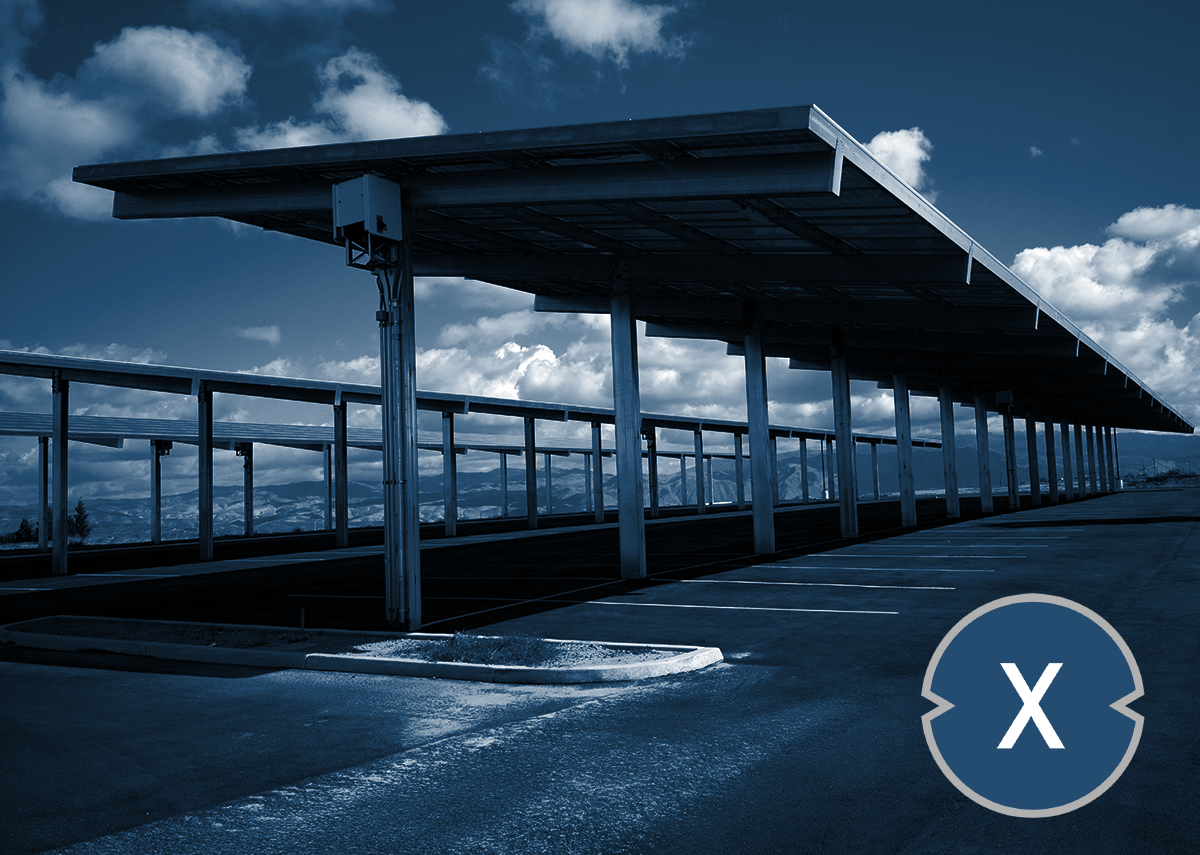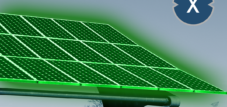
Covered solar carports generate electricity and protect parking areas - Image: Xpert.Digital / Richard Thornton|Shutterstock.com
Multifunctional roofing of sealed and open parking areas with solar carports
A solar carport not only protects against wind and weather, it also supplies the electricity generated by solar energy. The more they produce their own electricity, the more independent they become from energy companies and political developments, which will become a major challenge in the coming years. You can only gain planning security for the next few years through your own autonomous power supply. A solar carport is an investment that will pay off over a certain period of time, depending on the size
- Electric vehicle charging station
- Electricity storage
- lighting
and other possibilities come naturally and even a profit can be lost. A solar carport can be used as a supplement or alternative to the roof of a house, office building or hall complex. The more you generate your own electricity, the more independent you are from rising electricity prices. The extreme longevity of a solar carport is another important point for your planning security. With solar modules you usually get a product and performance guarantee of up to 30 years.
Our solar carport solutions are modular and scalable:
- Quick and easy assembly
- Stable strip foundation as collision protection
- Individually customizable design (color, materials, surface, size, etc.)
- Installation of charging stations and inverters is possible at any time
- Scalable & modular: Available as a single, double or arbitrarily scalable row carport
- Can even be used in the standard version for very high wind and snow loads (s k = 2.2 kN/m²)
- Extra large and wide parking spaces and very easy parking thanks to W-shaped supports
- High-quality design for sophisticated and long-lasting requirements: Hot-dip galvanized steel construction (DIN EN 10346, DIN EN 1461)
📣 Parking areas solar solutions for industry, retail and municipalities
Everything from a single source, specially designed for solar solutions for large parking areas. You refinance or counterfinance into the future with your own electricity generation.
🎯 For solar engineers, plumbers, electricians and roofers
Advice and planning including a non-binding cost estimate. We bring you together with strong photovoltaic partners.
👨🏻 👩🏻 👴🏻 👵🏻 For private households
We are positioned across regions in German-speaking countries. We have reliable partners who advise you and implement your wishes.
With over 1,000 specialist articles, we cannot present all topics here. Therefore, you will find a small excerpt from our work here and we would be pleased if we have piqued your interest in getting to know us better:
Our photovoltaics library (PDF)
Large PDF library: Market monitoring and market intelligence on the subject of photovoltaics.
Data is viewed at regular intervals and checked for relevance. This usually brings together some interesting information and documentation, which we combine into a PDF presentation: our own data analyzes and marketing intelligence as well as external market observations.
More about it here:
How high is the number of new charging stations in Germany?
Around 4,500 new charging stations for electric cars went into operation across Germany in 2020 and completed the Federal Network Agency's notification process. The biggest increase so far was in 2019 with over 5,000 new charging stations. In total, there are already over 19,600 charging stations for electric cars in Germany.
The source states: “The map shows the charging facilities of all operators who have completely completed the Federal Network Agency’s notification process and agreed to publication on the Internet. The LSV does not enable a complete recording of the entire German charging infrastructure. The number of publicly accessible charging facilities in Germany is therefore larger than shown here.”
Due to late registrations, the data from previous years may change.
How is the development of new charging stations in Germany?
- 2010 – 89 charging stations
- 2011 – 254 charging stations
- 2012 – 153 charging stations
- 2013 – 144 charging stations
- 2014 – 315 charging stations
- 2015 – 620 charging stations
- 2016 – 1,174 charging stations
- 2017 – 2,040 charging stations
- 2018 – 4,107 charging stations
- 2019 – 5,019 charging stations
- 2020 – 4,530 charging stations
Who is planning to purchase or modernize a solar system?
People who are planning to modernize a solar system after vocational training – Image: Xpert.Digital
People in Germany who are planning to modernize or purchase a new solar system (photovoltaic system) after vocational training compared with the population
According to projections, around 3.31 million people in Germany were definitely planning to modernize or purchase a new solar system/photovoltaic system in 2020. In this group of people, around 22.9 percent of people had a university degree. Meanwhile, around 11.6 percent of the population had such a qualification.
People who are planning to modernize a solar system after vocational training
Population
- 2.5% – Still in training
- 3.6% – apprenticeship without a qualification
- 56.3% – Apprenticeship with qualification (journeyman/skilled worker certificate)
- 8.6% – trade school/technical school with a degree, master craftsman’s certificate
- 6.4% – technical college degree (also engineering school degree)
- 11.6% – University degree
- 3.3% – Other vocational training
- 14.7% – None of the above
People who are definitely/perhaps planning to modernize their solar system/photovoltaics
- 2.4% – Still in training
- 1.6% – apprenticeship without qualification
- 45.6% – apprenticeship with qualification (journeyman/skilled worker certificate)
- 13% – trade school/technical school with a degree, master’s certificate
- 9.5% – technical college degree (also engineering school degree)
- 22.9% – University degree
- 3.5% – Other vocational training
- 18% – None of the above
How is the newly installed photovoltaic capacity distributed in Europe?
Outdoor photovoltaic systems were already the most widespread in Europe in 2013 - Image: Xpert.Digital
The statistics show the distribution of the newly installed output of photovoltaic systems in Europe by segment in 2013. With a share of 34 percent, predominantly outdoor PV systems were newly installed in Europe in 2013.
Photovoltaics – Most installed photovoltaic capacity by area
- 34% – outdoor systems
- 27% – Commercial
- 22% – Housing
- 17% – Industry
How did Fukushima change Japan's energy mix?
9 years later. The March 11, 2011 nuclear incident at Fukushima, Japan, made international headlines for months, but it also changed Japanese attitudes toward nuclear energy. After a devastating tsunami that hit Japan on March 11, 2011, emergency generators cooling the Fukushima nuclear power plant failed, causing a total of three meltdowns, explosions and the release of radioactive material into surrounding areas.
Before the incident, the Japanese were known as steadfast supporters of nuclear energy, despite previous nuclear disasters at Three Mile Island (USA) and Chernobyl (Ukraine). But a nuclear meltdown on their own soil changed the minds of many citizens and galvanized the anti-nuclear movement.
After mass protests, the Japanese government under then-Prime Minister Yoshihiko announced plans to make Japan nuclear-free by 2030 and not to rebuild any of the damaged reactors. New Prime Minister Shinzo Abe has since tried to change the nation's opinion on nuclear energy by emphasizing that the technology is actually carbon neutral and well suited to meeting emissions targets.
More about it here:
How high is the renewable electricity mix in Germany?
According to the Fraunhofer Institute for Solar Energy Systems, 47 percent of the electricity generated in Germany this year comes from renewable sources. Up to and including mid-July, wind and solar systems in this country produced almost 100 terawatt hours (TWh) of electricity. For comparison: For lignite and hard coal it was 84 TWh. According to a report by the Handelsblatt, the share of coal-fired power plants in German electricity generation fell surprisingly sharply in the first half of the year. “Wind, solar and even gas systems are displacing hard coal-fired power plants from the market on a large scale, but increasingly also lignite plants.”
More about it here:
Are the fastest growing jobs the best paying?
Two of the five fastest-growing job titles in the U.S. also offer median wages that are below the U.S. annual median, according to the Bureau of Labor Statistics. Jobs for solar photovoltaic installers are expected to grow 63 percent over the next decade, nearly ten times faster than overall job growth. The median wage for working in this job is currently about $5,000 above the median.
This trend is changing for work in healthcare. The fastest growing sector is healthcare, with healthcare jobs predicted to grow 18.2 percent over the next decade. The specific occupations experiencing the highest growth are home health care and personal care, with growth projections for both job titles at 37 and 36 percent, respectively. Although both job titles are twice the growth prospects of their industry as a whole, both occupations are well below the national average annual wage. About fifty percent of both job titles earn less than $24,000 per year.
More about it here:
Is Florida really America's sunshine state?
After years of rapid expansion, U.S. solar employment peaked at 260,000 in 2016 before stalling amid tariffs imposed by the Trump administration. These tariffs on crystalline silicon modules and cells were among the factors that led to a decline in jobs for two consecutive years, with the number of employees falling to 244,340 in 2018. The Solar Foundation has released its latest National Solar Job Census, which contains good news for the industry after this period of uncertainty: Employment in the solar industry has increased again, increasing 2.3 percent to 249,983.
31 states saw solar employment increase in 2019, led by Florida. Proving that Florida truly is America's Sunshine State, it has seen an expansion in residential and utility solar installations, as well as an increase in the availability of solar leasing, allowing installers to offer more attractive financing options to their customers. The solar industry added 1,843 jobs, the highest absolute number of any US state. The Southeast was generally a bright spot in this year's count, with strong job growth driven by utility expansion and new manufacturing jobs.
More about it here:
- Plan photovoltaics for warehouses, commercial halls and industrial halls
- Industrial plant: Plan a photovoltaic open-air system or open-space system
- Plan solar systems with photovoltaic solutions for freight forwarding and contract logistics
- B2B solar systems and photovoltaic solutions & advice
Solar system solutions: Xpert.Solar for planning and consulting in the area of solar carports, solar systems on roofs and photovoltaic systems in general for Krefeld, Oberhausen, Hagen and Hamm
I would be happy to serve as your personal advisor.
You can contact me by filling out the contact form below or simply call me on +49 89 89 674 804 .
I'm looking forward to our joint project.
Xpert.Digital – Konrad Wolfenstein
Xpert.Digital is a hub for industry with a focus on digitalization, mechanical engineering, logistics/intralogistics and photovoltaics.
With our 360° business development solution, we support well-known companies from new business to after sales.
Market intelligence, smarketing, marketing automation, content development, PR, mail campaigns, personalized social media and lead nurturing are part of our digital tools.
You can find out more at: www.xpert.digital – www.xpert.solar – www.xpert.plus

